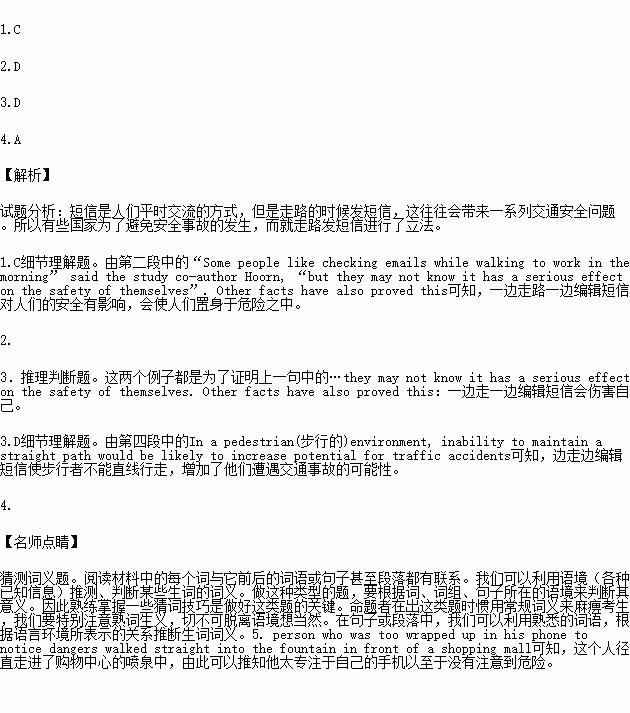题目内容
Texting(发短信)walkers aren't just an annoyance to other walkers, Australian researchers armed with movie special-effects technology have determined scientifically that they're threats to themselves. Using motion-capture technology similar to that used for films, researchers concluded that texting while walking not only affects balance but also the ability to walk in straight line.
“Some people like checking emails while walking to work in the morning” said the study co-author Hoorn, “but they may not know it has a serious effect on the safety of themselves”. Other facts have also proved this. A tourist from Taiwan walked off a pier near Melbourne last month while checking Facebook, bringing a sudden and icy end to a penguin-watching visit. Another person who was too wrapped up in his phone to notice dangers walked straight into the fountain in front of a shopping mall.
The Australian study involved 27 volunteers, a third of whom admitted having knocked into objects while texting. They were asked to walk 8.5 meters three times—once without phones, once while reading text and once while writing text, when eight cameras recorded their actions.
They found the volunteers using the phone walked slower, and, more seriously, they locked their arms and elbows in like “robots”, which forced their heads to move more, throwing themselves off balance. “In a pedestrian(步行的)environment, inability to maintain a straight path would be likely to increase potential for traffic accidents”, said Mr. Hoorn. “The best thing to do is to step aside and stop, or keep off the phone.”
Authorities world-wide have taken note. Signs on Hong Kong's subway system advise passengers in three languages to keep their eyes off their phones. Police and transport authorities have highlighted the danger in Singapore, where the Straits Times newspaper recently declared cellphone-distracted road crossing as “bad habit No. 2” contributing to the rising number of road deaths. Some U.S. states, including New York and Arkansas, are considering bans on what they're calling phone jaywalking.
1.According to the passage, people texting while walking usually____________.
A. do not influence other walkers
B. do harm to their eyes
C. put themselves in danger
D. can still walk straight
2.【Which of the following words has the closest meaning to “wrapped up” in Paragraph 2?
A. absent-minded B. annoyed
C. confused D. absorbed
3.About the Australian study, we know that___________.
A. the volunteers using phones while walking moved normally
B. ten volunteers admitted having bumped into things while texting
C. the volunteers were divided into three groups during the study
D. texting walkers are exposed to greater possibility of traffic accidents
4.The last paragraph suggests that_________.
A. actions have been taken against texting while walking
B. Hong Kong’s subway system forbids texting walkers to take the train
C. New York has made laws to ban phone jaywalking
D. cellphone-distracted road crossing is considered the worst habit in Singapore

